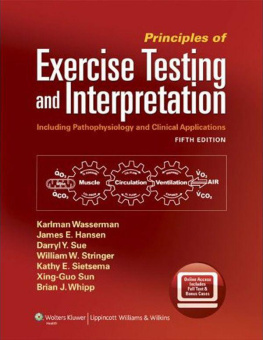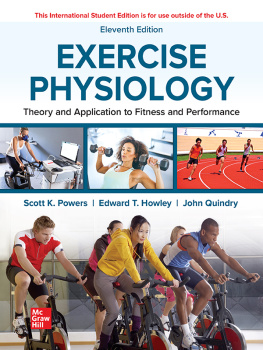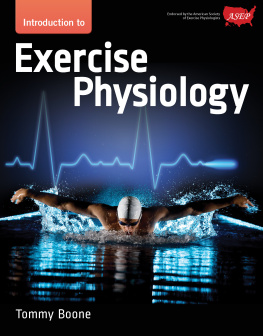Acquisitions Editor: Frances R. DeStefano
Product Manager: Leanne Vandetty
Production Manager: Alicia Jackson
Senior Manufacturing Manager: Benjamin Rivera
Marketing Manager: Kimberly Schonberger
Design Coordinator: Teresa Mallon
Production Service: Absolute Service, Inc.
2012 by LIPPINCOTT WILLIAMS & WILKINS, a WOLTERS KLUWER business
Fourth Edition 2005 by LIPPINCOTT WILLIAMS & WILKINS
Third Edition 1999 by LIPPINCOTT WILLIAMS & WILKINS
Second Edition 1994 by Lea & Febiger
Two Commerce Square
2001 Market Street
Philadelphia, PA 19103 USA
LWW.com
All rights reserved. This book is protected by copyright. No part of this book may be reproduced in any form by any means, including photocopying, or utilized by any information storage and retrieval system without written permission from the copyright owner, except for brief quotations embodied in critical articles and reviews. Materials appearing in this book prepared by individuals as part of their official duties as U.S. government employees are not covered by the above-mentioned copyright.
Printed in China
Library of Congress Cataloging-in-Publication Data
9781609138998
1609138996
Principles of exercise testing and interpretation : including pathophysiology and clinical applications / Karlman Wasserman [et al.]. 5th ed.
p. ; cm.
Includes bibliographical references and index.
ISBN 978-1-60913-899-8 (hardback : alk. paper)
I. Wasserman, Karlman.
[DNLM: 1. Exercise Test. 2. Physical Exertion-physiology. WG 141.5.F9]
616.1'20754dc23
2011036549
Care has been taken to confirm the accuracy of the information presented and to describe generally accepted practices. However, the authors, editors, and publisher are not responsible for errors or omissions or for any consequences from application of the information in this book and make no warranty, expressed or implied, with respect to the currency, completeness, or accuracy of the contents of the publication. Application of the information in a particular situation remains the professional responsibility of the practitioner.
The authors, editors, and publisher have exerted every effort to ensure that drug selection and dosage set forth in this text are in accordance with current recommendations and practice at the time of publication. However, in view of ongoing research, changes in government regulations, and the constant flow of information relating to drug therapy and drug reactions, the reader is urged to check the package insert for each drug for any change in indications and dosage and for added warnings and precautions. This is particularly important when the recommended agent is a new or infrequently employed drug.
Some drugs and medical devices presented in the publication have U.S. Food and Drug Administration (FDA) clearance for limited use in restricted research settings. It is the responsibility of the health care provider to ascertain the FDA status of each drug or device planned for use in their clinical practice.
To purchase additional copies of this book, call our customer service department at (800) 638-3030 or fax orders to (301) 223-2320. International customers should call (301) 223-2300.
Visit Lippincott Williams & Wilkins on the Internet at LWW.com. Lippincott Williams & Wilkins customer service representatives are available from 8:30 am to 6 pm, EST.
10 9 8 7 6 5 4 3 2 1
To Our Families

I n this fifth edition of Principles of Exercise Testing and Interpretation, as in earlier editions, we attempt to develop conceptual advances in the physiology and pathophysiology of exercise, particularly as related to the practice of medicine. The underlying theme of the book continues to be the recognition that the most important requirement for exercise performance is transport of oxygen to support the bioenergetic processes in the muscle cells (including, of course, the heart) and elimination of the carbon dioxide formed as a byproduct of exercise metabolism. Thus, appropriate cardiovascular and ventilatory responses are required to match those of muscle respiration in meeting the energy demands of exercise.
As depicted by the logo on the book cover, normal exercise performance requires an efficient coupling of external to internal (cellular) respiration. Appropriate treatment of exercise intolerance requires that patients' symptoms be thought of in terms of a gas exchange defect between the cell and the environment. The defect may be in the lungs, heart, peripheral or pulmonary circulations, the muscles themselves, or there may be a combination of defects. Thus, we describe the pathophysiology in gas transport and exchange that affect any site in the cardiorespiratory coupling between the lungs and the muscles.
We illustrate how cardiopulmonary exercise testing can provide the means for a critical evaluation by the clinician-scientist of the functional competency of each component in the coupling of cellular to external respiration, including the cardiovascular system. To achieve this, clinical cases are used to illustrate the wide spectrum of pathophysiology capable of causing exercise intolerance.
The primary symptoms causing exercise intolerance, typically dyspnea and/or fatigue, are shown to have a rational pathophysiological basis. Without cardiopulmonary exercise testing, the treatment of patients with exercise intolerance may be improperly focused because the pathophysiology causing the exercise intolerance may not be well understood by the physician working within the diagnostic spectrum of his or her subspecialty. Exertional dyspnea and/or fatigue at unusually low levels of exercise can often be traced to abnormal coupling of the cardiopulmonary mechanisms required for normal gas exchange. Therefore, by measuring gas exchange during cardiopulmonary exercise tests, not only can the exercise limitation be quantified, but the functional adequacy of the heart, circulatory system, and lungs also can be established. Fortunately, this can usually be done noninvasively.
We believe that each chapter of this book makes original contributions to the understanding of exercise physiology. In particular, provide extensive information about changes in arterial, mixed venous, and femoral vein blood gases and arterial lactate during lower extremity exercise. These chapters are valuable for differentiating the function of the peripheral from central circulations and describe mechanisms that enable favorable shifts in the oxyhemoglobin and CO2 dissociation curves to optimize arterial-venous differences and minimize changes in muscle capillary PO2 and PCO2.
The gas exchange responses to exercise can indicate to the investigator which organ(s) are functioning poorly and which are functioning well. Because the pattern of the gas exchange response is characteristic of the disease process, it can enable a clinical diagnosis. For instance, cardiopulmonary exercise testing might not only detect cardiovascular limitation, but could also be used to distinguish which cardiovascular disease restricts the patient's exercise performance when several might coexist, such as coronary artery disease, chronic heart failure, and peripheral vascular disease. describes a flowchart approach to assist in making a clinical diagnosis, using the physiological data obtained during cardiopulmonary exercise testing. It is likely that no test in medicine can be used to diagnose the broad spectrum of diseases, while quantifying severity of organ dysfunction or improvement in the pathophysiology of exercise intolerance, better and more cheaply than cardiopulmonary exercise testing. As a referral center for problematic cases, we are often impressed with the revelations of pathophysiology provided by cardiopulmonary exercise testing.









